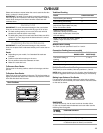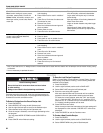
15
Broil
Broiling uses direct radiant heat to cook food. Changing the
temperature when broiling allows more precise control when
cooking. The lower the temperature, the slower the cooking.
Thicker cuts and unevenly shaped pieces of meat, fish and
poultry may cook better at lower broiling temperatures.
■ For best results, use a broiler pan and grid. They are
designed to drain juices and help avoid spatter and smoke.
If you would like to purchase a Premium Broil Pan and
Roasting Rack, a set may be ordered. See “Assistance or
Service” section to order. Ask for Part Number W10123240.
■ For proper draining, do not cover the grid with foil. The
bottom of the pan may be lined with aluminum foil for easier
cleaning.
■ Trim excess fat to reduce spattering. Slit the remaining fat on
the edges to avoid curling.
■ Pull out oven rack to stop position before turning or removing
food. Use tongs to turn food to avoid the loss of juices. Very
thin cuts of fish, poultry or meat may not need to be turned.
■ After broiling, remove the pan from the oven when removing
the food. Drippings will bake on the pan if left in the heated
oven, making cleaning more difficult.
Before broiling, position rack according to the Broiling Chart.
Preheat broil for about 5 minutes. Position food on grid in the
broiler pan, then place it in the center of the oven rack. Close the
door to the broil stop position to ensure proper broiling
temperature.
To Broil:
Before broiling, position rack according to the Broiling Chart.
1. Press BROIL.
2. “HIGH” and “LOW” will be displayed.
Use the Quickset pads to select HIGH (550°F/290°C) for
normal broiling or LOW (450°F/230°C) for low-temperature
broiling.
OR
To select a broil temperature other than High or Low, enter
the desired temperature (300°F/149°C to 550°F/288°C) using
the number pads and press ENTER.
3. Press CANCEL when finished.
BROILING CHART
For best results, place food 3" (7.0 cm) or more from the broil
element. Times are guidelines only and may need to be adjusted
for individual tastes. Recommended rack positions are numbered
from the bottom (1) to the top (5). For diagram, see the
“Positioning Racks and Bakeware” section.
Convection Cooking
(on some models)
In a convection oven, the fan-circulated hot air continually
distributes heat more evenly than the natural movement of air in a
standard thermal oven. This movement of hot air helps maintain a
consistent temperature throughout the oven, cooking foods more
evenly, crisping surfaces while sealing in moisture and yielding
crustier breads.
Most foods can be cooked by lowering cooking temperatures
25°F to 50°F (14°C to 28°C), and cooking time can be shortened
by as much as 30 percent, especially for large turkeys and roasts.
■ It is important not to cover foods with lids or aluminum foil so
that surface areas remain exposed to the circulating air,
allowing browning and crisping.
■ Keep heat loss to a minimum by opening the oven door only
when necessary.
■ Choose cookie sheets without sides and roasting pans with
lower sides to allow air to move freely around the food.
FOOD RACK
POSITION
TOTAL
TIME
MIN.
Steak
1" (2.5 cm) thick
medium
well-done
4
4
18-20
18-22
Ground meat patties
½" (1.3 cm) thick
well-done 4 10-12
Pork chops
1" (2.5 cm) thick
Bone-in
Boneless
4
4
25-28
20-28
Ham slice, precooked
1" (2.5 cm) thick
warm 4 12-16
Chicken
bone-in breasts
boneless, skinless breasts
3
4
LOW broil
20-33
12-15
Seafood
Fish Steaks
1" (2.5 cm) thick
flaky
Lobster tails
3-4 oz (85-113 g) each
3 or 4
4
10-14
7-10


















